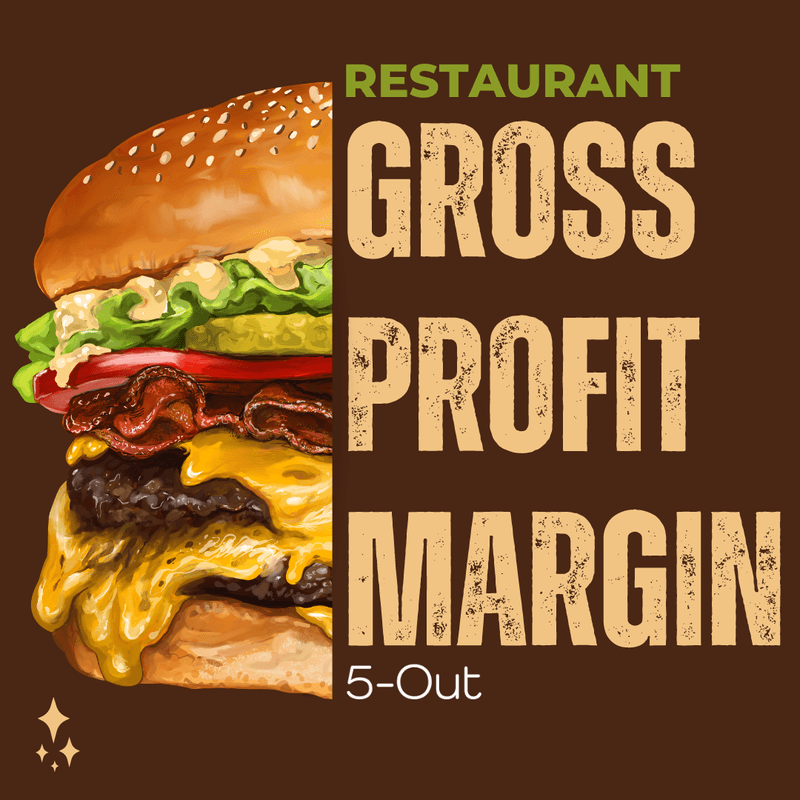What is Restaurant Gross Profit Margin
- Erin Watkins

- Jul 26, 2024
- 7 min read
Restaurant gross profit margin is the money left over from your sales after you've paid for the cost of the food and beverages you've sold.
Revenue Optimization

For restaurant owners, running a successful restaurant business isn't just about great food and service. It's also about understanding the numbers behind your operation. One of the most critical numbers for restaurant owners to know is their restaurant's gross profit margin.
Restaurant gross profit margin is the money left over from your sales after you've paid for the cost of the food and beverages you've sold. Understanding and managing your gross profit margin is crucial for several reasons in your restaurant business. It shows how efficiently you're using your resources and managing operating expenses. It helps you price your menu items correctly to balance profitability and customer satisfaction. It allows you to compare your performance to industry standards, giving you a benchmark for your restaurant business. It can highlight areas where you might be overspending on operating expenses or undercharging for your offerings. Most importantly, it's a key factor in your overall profitability and the long-term success of your restaurant business.

Understanding Restaurant Gross Profit Margin
To effectively manage your restaurant's finances, you need to understand the gross profit margin inside and out. Let's break it down into manageable pieces.
The Formula for Calculating Gross Profit Margin
The formula for calculating gross profit margin is straightforward:
Gross Profit Margin = ((Total Revenue - Cost of Goods Sold) / Total Revenue) x 100
Here's what each part means:
Total Revenue: All the money your restaurant brings in from sales.
Cost of Goods Sold (COGS): The direct costs of the food and beverages you've sold.
For example, if your restaurant made $10,000 in sales last month and your COGS was $3,500, your gross profit margin would be:
((10,000 - 3,500) / 10,000) x 100 = 65%
This means you keep 65 cents of every dollar in sales after accounting for the cost of food and beverages.
Understanding Net Profit Margin
While gross profit margin is crucial, it's also important to understand net profit margins. Net profit margin takes into account all expenses, not just COGS.
The formula for net profit margin is:
Net Profit Margin = (Net Income / Total Revenue) x 100
Net Income is what's left after subtracting all expenses (including COGS, labor, rent, utilities, etc.) from your total revenue.
For example, if your restaurant's total revenue is $10,000, and after all expenses, you're left with $1,000, your net profit margin would be:
(1,000 / 10,000) x 100 = 10%
This means you're keeping 10 cents of every dollar in sales after accounting for all expenses.
Industry Benchmarks for Different Types of Restaurants
Gross profit margins can vary widely depending on the type of restaurant. Here are some general benchmarks:
Full-service restaurants: 60-70%
Fast-casual restaurants: 65-75%
Bars and pubs: 70-80%
Remember, these are averages. Your specific margin may be higher or lower based on various factors.
Factors Affecting Gross Profit Margin in the Restaurant Industry
Several factors can impact your restaurant's gross profit margin:
Food costs: Rising ingredient prices can eat into your margin if you don't adjust menu prices.
Menu pricing: Underpricing items can lead to lower margins, even if sales are high.
Portion sizes: Oversized portions increase food costs without necessarily increasing revenue.
Waste and spoilage: Proper inventory management is crucial to minimize losses.
Sales mix: The balance of high-margin and low-margin items sold affects the overall restaurant profit margin.
Seasonality: Some ingredients may cost more during certain times of the year.
Location: Rent and local ingredient costs can vary widely by location.
Restaurant concept: Fine dining establishments often have higher restaurant profit margins than fast food chains.
Understanding these factors helps you identify areas where you can potentially improve your gross profit margin.

Analyzing Your Current Gross Profit Margin
Understanding where your restaurant stands in terms of gross profit margin is crucial for making informed business decisions. Let's walk through how to analyze your current situation.
Tools and Software for Tracking Gross Profit Margin
Several tools can help you track and analyze your gross profit margin:
Point of Sale (POS) systems: Many modern POS systems, like Toast or TouchBistro, can track sales and inventory, providing real-time gross profit margin data.
Accounting software: These tools offer restaurant-specific features for tracking financial metrics, including gross profit margin.
Inventory management systems: Tools like MarketMan can help you track COGS more accurately.
Spreadsheet software: For smaller operations, a well-designed Excel or Google Sheets template can be effective for tracking gross profit margin.
Sales forecasting platforms: All-in-one solutions like 5-Out integrate with inventory management, POS, and other restaurant management platforms to predict future demands. These platforms can automate many processes, helping to reduce waste and costs while maximizing profit margins.
Red Flags to Watch Out for in Your Calculations
When analyzing your gross profit margin, be alert for these warning signs:
Sudden drops in margin: If your margin decreases significantly from one period to the next, investigate immediately. It could indicate rising food costs, theft, or pricing issues.
Margins well below the industry average profit margin: If you're consistently below the benchmark for your restaurant type, you may need to reassess your pricing or cost control measures.
Inconsistent margins across menu items: Some items should have higher margins than others, but extreme variations could suggest pricing or portioning issues.
A steady decline over time: A gradual decrease in margin over several months could indicate a systemic problem, such as inefficient operations or increased competition.
Margins that seem too good to be true: If your margins are significantly higher than the average restaurant profit margin, double-check your calculations. You might be missing some costs.
Large discrepancies between theoretical and actual food cost: If your actual food cost is much higher than what your recipes suggest it should be, you may have issues with waste, theft, or overportioning.
By regularly calculating and analyzing your gross profit margin, you can catch these red flags early and take corrective action to keep your restaurant financially healthy.

Strategies to Improve Your Restaurant's Gross Profit Margin
Improving your restaurant's gross profit margin requires a multifaceted approach. Let's explore some effective strategies you can implement.
1. Menu Engineering and Pricing Strategies
Menu engineering is the art and science of maximizing your menu's profitability. Here are key strategies:
Analyzing menu item profitability: Categorize your menu items based on their popularity and profitability. Use this data to make informed decisions about which items to promote, modify, or remove.
Implementing strategic pricing: Price your menu items based on their food cost percentage, perceived value, and market positioning. Consider using psychological pricing techniques, such as charm pricing (e.g., $9.99 instead of $10).
Balancing high and low-margin items: Ensure your menu has a mix of high-margin items (like pasta dishes or cocktails) and low-margin items (like steaks). Use low-margin items to attract customers, then encourage them to also order high-margin items.
2. Cost of Goods Sold (COGS) Optimization
Reducing your COGS directly improves your gross profit margin. Here's how to optimize:
Negotiating with suppliers: Build strong relationships with your suppliers and negotiate better prices. Consider bulk purchasing for frequently used items, but be mindful of storage space and shelf life.
Implementing portion control: Standardize your recipes and use portion control tools like scales and measuring cups. This ensures consistency and prevents overserving, which can eat into your profits.
Reducing food waste: Implement a first-in, first-out (FIFO) inventory system, use prep lists to avoid overproduction, and find creative ways to use trim and off-cuts in specials or staff meals.
3. Labor Cost Management
While labor costs aren't part of the gross profit margin calculation, they significantly impact your overall profitability. Here's how to manage them effectively:
Optimizing staff scheduling: Use historical sales data to predict busy periods and schedule staff accordingly. Avoid overstaffing during slow periods and consider using part-time staff to cover peak hours.
Cross-training employees: Train your staff to perform multiple roles. This flexibility allows you to operate with fewer staff members during slower periods while maintaining service quality.
Implementing productivity-enhancing technologies: Invest in technologies that can improve staff efficiency. This might include kitchen display systems, handheld POS devices for servers, or inventory management software.
By implementing these strategies, you can work towards improving your restaurant's gross profit margin. Remember, it's an ongoing process that requires constant monitoring and adjustment. Regularly review your progress and be prepared to fine-tune your approach as needed.

Advanced Techniques for Maximizing Gross Profit Margin
Once you've implemented basic strategies, consider these advanced techniques to further maximize your restaurant's gross profit margin.
1. Leveraging Data Analytics for Decision-Making
Data analytics can provide powerful insights to drive profitability. Here's how to leverage it:
Implement a comprehensive data collection system that tracks sales, inventory, customer preferences, and operational metrics.
Use data visualization tools to identify trends and patterns in your business performance.
Make data-driven decisions about menu offerings, pricing, promotions, and operational changes.
Regularly analyze your data to identify areas for improvement and measure the impact of changes you implement.
2. Implementing a Robust Inventory Management System
An advanced inventory management system can significantly reduce costs and improve efficiency:
Use barcode or RFID technology for accurate and efficient inventory tracking.
Implement a perpetual inventory system that updates in real-time as ingredients are used.
Set up automatic reordering based on predetermined par levels to prevent stockouts and overordering.
Use inventory data to identify slow-moving items and adjust purchasing or menu offerings accordingly.
3. Exploring Alternative Revenue Streams
Diversifying your revenue can increase overall profitability:
Develop a catering service to tap into the lucrative event market.
Create meal kits or ready-to-cook packages for customers to enjoy your food at home.
Offer cooking classes or chef's table experiences for additional high-margin revenue.
Develop a line of branded products (e.g., sauces, spice blends) for retail sale.
4. Utilizing Sales Forecasting Tools
Sales forecasting can help you optimize your operations and improve restaurant profit margins. Let's take a look at how an advanced platform like 5-Out can revolutionize your approach:
5-Out Implement AI-powered demand forecasting to accurately predict future sales, allowing for precise ingredient purchasing and reducing waste.
Use 5-Out's integrated inventory management system to track stock levels in real-time and set up automatic inventory in item levels based on forecasted demand.
Optimize staff scheduling by leveraging 5-Out's forecasting data to predict busy periods, controlling labor costs while maintaining service quality.
Take advantage of 5-Out's integration with your POS system to gather comprehensive sales data and improve forecast accuracy.
Use 5-Out's analytics dashboard to identify slow-moving menu items and plan promotions during predicted slow periods to boost sales.
Regularly review 5-Out's performance reports to measure the impact of your strategies and make data-driven decisions for continuous improvement.
By implementing these advanced techniques with a tool like 5-Out, you can take your restaurant's gross profit margin management to the next level. The platform's all-in-one approach integrates sales forecasting, inventory management, and data analytics, providing a comprehensive solution for maximizing your profit margins.
Click here to request a demo of 5-Out and start maximizing your restaurant's gross profit margin today!
Remember, while these strategies and tools can yield significant returns in the long run, they do require an initial investment in technology and training. Always monitor the results of your efforts and be prepared to adjust your approach as needed to achieve optimal results for your unique restaurant operation.



Comments